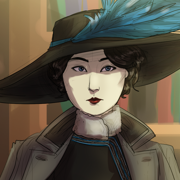|
sloth flu is just a really bad malaise.
|
|
|
|

|
| # ? May 29, 2024 08:52 |
|
Snipee posted:I love the idea of giant sloths (and native horses) surviving in this timeline and allowing the Native Americans to develop much more rapidly. Forget about the Aztecs. We should have seen an invasion by the Compache or Iroquois. A lot of that is going to depend upon when it was domesticated. Transmission of developments is a lot slower north/south than it is east/west as the differing climate and biomes present a barrier. Sloth husbandry would probably have began in the Andes since it historically developed earlier and then spread northward. It'd probably take 800 to 1600 years for it to just reach Mesoamerica and another thousand just to make its way up to the Great Plains. The Pacific Northwest or Algonquin tribes of New England would probably domestic ground sloths first.
|
|
|
|
Rubix Squid posted:A lot of that is going to depend upon when it was domesticated. Transmission of developments is a lot slower north/south than it is east/west as the differing climate and biomes present a barrier. Sloth husbandry would probably have began in the Andes since it historically developed earlier and then spread northward. It'd probably take 800 to 1600 years for it to just reach Mesoamerica and another thousand just to make its way up to the Great Plains. The Pacific Northwest or Algonquin tribes of New England would probably domestic ground sloths first. Yes, but horse-drawn agriculture by itself would have completely changed the historical trajectory for the North Americans that didnít have any beasts of burden in OTL. It would have complimented the giant sloth husbandry of South America. The continued existence of horses in the Americas would have also dramatically altered the military balance of power between Eurasia and the Americas.
|
|
|
|
True but I'm not going to make any more assumptions about what does or does not go extinct unless Kangxi gives the okay.
|
|
|
|
One of the things that it's important to know about north america is that contrary to a lot of stereotypes, there were many, many settled people and urban sites there. The reason they vanished was entirely because of plague, too. EU4 does a terrible job of showing this, having them be semi-migratory at a point when they were settled and often extensive in their political and economic networks. However, it was either do that or have a player's entire nation literally vanish the moment some European expedition walks through. It can't be stated enough that European expansionism was actually the lesser threat: just contact with a European expedition often destroyed entire civilizations, annihilating towns and cities to the point where when European settlers arrived to the area, the people still living there had forgotten that they'd built the mounds that cities were once on. If plague of this scale is not a thing, the entire scenario of colonization in EU4 will be completely different: no more "empty spaces" to take.
|
|
|
|
Big example of this: the Amazon. There should be a thriving civilization there at this point, and presumably also in the EU4 conversion of this game. For something to do with Australia and New Zealand, I'll happily shill for lifting Lands of Red and Gold wholesale as the basis. I also have to imagine that in a world where Mexica overran the bulk of the Christian population you'd get some really bizarre syncretism between their religion and Christianity, more so than the OTL "we'll rename all the local deities and spirits to saints and hope the Church in Europe doesn't notice" variety.
|
|
|
|
|
NewMars posted:One of the things that it's important to know about north america is that contrary to a lot of stereotypes, there were many, many settled people and urban sites there. The reason they vanished was entirely because of plague, too. EU4 does a terrible job of showing this, having them be semi-migratory at a point when they were settled and often extensive in their political and economic networks. However, it was either do that or have a player's entire nation literally vanish the moment some European expedition walks through. It can't be stated enough that European expansionism was actually the lesser threat: just contact with a European expedition often destroyed entire civilizations, annihilating towns and cities to the point where when European settlers arrived to the area, the people still living there had forgotten that they'd built the mounds that cities were once on. If plague of this scale is not a thing, the entire scenario of colonization in EU4 will be completely different: no more "empty spaces" to take. Edit: I should have read the entire post before commenting. Yeah, the EU4 devs consciously avoided players having to play through decades of devastation, and just start north America off almost entirely depopulated. Dance Officer fucked around with this message at 07:33 on Jul 20, 2019 |
|
|
|
Rubix Squid posted:A lot of that is going to depend upon when it was domesticated. Transmission of developments is a lot slower north/south than it is east/west as the differing climate and biomes present a barrier. Sloth husbandry would probably have began in the Andes since it historically developed earlier and then spread northward. It'd probably take 800 to 1600 years for it to just reach Mesoamerica and another thousand just to make its way up to the Great Plains. The Pacific Northwest or Algonquin tribes of New England would probably domestic ground sloths first. The Aztec Invasion is actually Aztecs fleeing the Algonquin giant sloth invasion of Mesoamerica
|
|
|
|
Is it wrong to think of the Inca event? It mentions them getting gunpowder together.
|
|
|
|
I absolutely love this discussion, but I'm trying to hold off on any definitive statements about the rest of the world until we get closer to the EU4 conversion. I am thinking about setting up polls if I had to choose between multiple interesting options - both for how to portray Tibet, but also in setting up interesting scenarios for the rest of the world.
|
|
|
|
The Sandman posted:Big example of this: the Amazon. There should be a thriving civilization there at this point, and presumably also in the EU4 conversion of this game. Going to second Lands of Red and Gold as a really good idea for an AU Australia.
|
|
|
|
Lands of red and gold is the best. I might be biased though, considering I am Aboriginal Australian.
|
|
|
|
Thinking about it - if Mylodon (and Megatherium) were domesticated, it would most likely first have happened around the Pampas of Argentina, Uruguay and south Brazil. It's fairly flat terrain, temperate and generally equivalent to the Great Plains, or France and Germany. Temperatures are fairly mild, with frost only in a few months of the year, allowing for almost year-round agriculture. The risk of tornados exists, but isn't as crazy as in the modern US. This leads me to believe that the Pampas would have become the Americas' initial Cradle of Civilisation rather than the Norte Chico civilisation in Peru, possibly developing a few centuries earlier - or at the same time, which would be interesting, too. Assuming they develop alongside each other, we're looking at a situation not unlike the Middle East with initially competing city-states emerging, then slowly coalescing. The two civilisations would probably develop along wildly different lines, with Norte Chico's successors moving along the same lines as OTL, but possibly a little faster, with more stability as the Mylodon and Megatherium make their way into the Andes over the centuries. Our hypothetical Pampas civilisation could go along similar lines to either Sumerian civilisations, or along the lines of the Indus Valley civilisation (the Valley being another 'Cradle'' OTL, for the record), with significant cities emerging quite early-on. Around 2,000-1,500 BC we'd probably be looking at the some cities in the Amazon Forest popping up, with a significant chunk of the general continent sporting people bunched up like that. Mostly along the coastline or the Amazon River though, I figure. There is a decent amount of evidence that the Amazon could sustain at least 5 million people, perhaps a little more, with the methods of the time. With domesticated Sloths, we can safely raise that by 50% at least, if not more. Very disparate though, because I honestly don't think the locals would start burning the whole bloody forest down, rather than learning how to keep the forest alive while farming efficiently. By 1,000-500 BC we're likely looking at equivalent development as in Europe. There'd absolutely be a powerful iron-using civilisation in Bolivia, because 10% of the world's iron ore is in one place. And that's kinda crazy. Sky's the limit from here, and I still like the HRE-like coalition of states and statelets centered around the Andes being the 'Aztec' Empire's biggest enemy. Gunpowder is almost an afterthought, because with such widespread civilisation, hell yes they'd develop the stuff and militarise it. Feel free to pick and tear apart what I wrote, I'm mostly thinking out loud. Edit: Also, Kangxi, feel free to link to any of my poo poo. Lynneth fucked around with this message at 13:02 on Jul 20, 2019 |
|
|
|
The neat thing about this alt-history slothiculture is that the ground sloths lived in a ton of different climates, they were well adapted to both the plains and more alpine environments. They apparently lived in groups, too, so while I don't think they were naturally herd animals they wouldn't get that freaked out by being with/around others. I think the biggest issues in this timelines Columbian Exchange is the diseases, but since the Mesoamericans got here in the 12th century there's going to be several hundred years for the American populations to recover and develop resistances to Eurasian diseases. We'd probably see the aftershocks of that in the 15th century start of EUIV, and there probably would still be regions that had been mostly/entirely depopulated by waves of smallpox/influenza/typhus/cholera etc. The midwest in 1500 must have been apocalyptic. Plus, there's probably some type of bad illness that would go back the other way. Something like measles, which started off in domesticated herds as rindlepest and made the jump to humans around 1000 AD.
|
|
|
|
Lynneth posted:By 1,000-500 BC we're likely looking at equivalent development as in Europe. There'd absolutely be a powerful iron-using civilisation in Bolivia, because 10% of the world's iron ore is in one place. And that's kinda crazy. Sky's the limit from here, and I still like the HRE-like coalition of states and statelets centered around the Andes being the 'Aztec' Empire's biggest enemy. It would be incredibly funny if Tiawanaku was South America's Rome-like iron age hegemon that later polities are doomed to try to reach their heights and fail
|
|
|
|
Chapter 19: 1019 to 1021 - Tsenmo Purgyal Shonnu Transcript of a lecture delivered by Dr. Dimitris Bagdzevičius, a professor of military history at the Queen Dobrava Military Academy in Orsha. This is the second in his series on central Asian history. Good evening class. It's good to see so many of you still here, having not dropped out after the first class and the reading through my grading policy. But let's get right to it. The history of the Mongolian invasions is replete with myths. But with the discovery of Mongolian-language archives, indeed as well as a small outgrowth of scholars who can read and understand classical Mongolian, we can now uncover the realities of the war and counter the myths that have been prevalent in our history books for so long. Suffice to say that the wars of the 11th century - of the Great Western Invasion across the Atlantic, and the Mongolian campaigns against the numerous central Asian polities as well as the Later Han Dynasty, were unequaled until very recently. In terms of their scale, their scope, and their consequences - in terms of their enormous toil in material and personnel. In their campaigns, they had asked for no quarter and indeed gave none. The bulk of what I'm telling you comes from the recently translated Mongγol-un niγuča tobčiyan, or the "Secret History of the Mongols". So the Mongolian campaigns are one of those cases where we can rely on both primary sources, oral histories, and occasionally archaeological discoveries. These sources do not always agree - in fact, it is a rare event when they do! So I will try and present some of the most plausible series of events, or at least the more recent scholarly consensus. I've already gone over the life and legends around the life of Temulun. Her birth, her rise to power, her early feats and consolidation of the Mongol tribes. By 1019, she would launch an invasion of the Later Han Dynasty. Now the previous Jin or Jurchen dynasty had encouraged rivalries between some of the nomadic tribes, or in some extreme cases demanded tribute from them or carried out invasions. The Jurchens were able to carry this out successfully, but they were never really able to consolidate rule over the Han mainland. When they were deposed in 1004, the later Han Dynasty took their place. Now the Han were not nearly as capable in managing the 'northern barbarians'. They had demanded tribute, expecting it to be given without any demonstration of power. This was one insult too many to bear, but the Mongols did not strike immediately. In the early 1010s, a massive outbreak of disease swept through the Han - later scholars have speculated this was the bubonic plague. Later estimates based on tax rolls state that as much as 30 percent of the population was lost. When this plague finally receded, it was at this time that the Mongols had decided to invade. It was a strategy of striking when the enemy was weak, as well as avoiding a spread of the plague among their own population, but also a case of calculated revenge. When the Mongols had asked for tribute, they were dismissed out of hand by the Han court. While Temulun had already consolidated many of the Mongol tribes into a confederation, they were still fairly small and obscure by Han standards. The Han emissary had said, "Our Empire is like the sea; yours is but a handful of sand ... How can we fear you?" Famous last words. Now slightly after they had started the invasion of the later Han, they had decided to go after the Tibetan Empire. This was in 1019, around the time the Great Western Invaders had sacked Paris and Rouen. Now you might ask, why go after two of the largest and most populous land powers in Central Asia at the same time? I will get to their war goals in a minute. The Tibetans' first response was lackluster at first - The empress Shonnu only ordered the border garrisons to get ready, a force of perhaps 2,000 to 4,000 troops under arms, While the Mongols threw an entire force of 75,000-90,000 at them. Some of these were Mongol troops, some were Jurchens who rebelled against the Han, some, in fact, were turncoats from the Han themselves. Now the first towns here fell quickly, and their garrisons were completely swept aside. One or two of the early ones surrendered. Now the Mongol Secret History tells us they in fact spared some of the first urban settlements they came across. If you were in one of the first towns they came across, you were likely to survive, as they needed those for logistics purposes. But if you refused them, or attempted to fight against them for too long, then you were more likely to be in trouble. In the summer of 1019, the Tibetan and Mongolian armies first met at Yumen Pass. You may know this place if you've studied your Tibetan or Chinese literature. It was the old 'gate to the west' of the Tang Dynasty, and also the place where the Tibetan empress Gyalyum scored some of her greatest victories in legend. You'll note this was one of the first and one of the very few times Mongol armies were defeated in the open field. The Secret History is very frank about the reasons for the Tibetans' victory - the enemy had the advantage of more narrow terrain, some fortifications which were still maintained after the fall of the Tang Dynasty, and relatively inexperienced Mongol commanders. The Mongols attacked again near the same site, and the Tibetans were able to hold them back. If it were possible, the Tibetans would have been free to enjoy this advantage. But it was not really possible. This was, in fact, the rear guard of the Mongolian army, and the bulk of the main force was advancing westward through the Tarim Basin, sacking cities as they went. While the Tibetan army advanced very slowly to Dunhuang, they thought they could catch another one of these smaller groups off guard. This was one of the Mongol tactics we will see very well in the other lessons. They would first attempt to bait the other army with a smaller force, And then attack again with a hidden force which would attack from an alternate side. The Tibetan army won here, but this was against a Pyrrhic victory. They could not afford to take substantial losses, whereas the Mongols were at this point able to draw from a pool of conscripted Jurchens and Han Chinese. They were not able to move fast enough to recover the cities that the Mongols were taking, And in the victories they were able to achieve this far were totally balanced out by the fact that the Mongols had already sacked almost everything from Endere to Lop Nor. The Mongols attacked again, and this was more of a harassment than an outright attack. The Mongols were more ambivalent about this battle, but the Tibetan sources call it a victory. By this point, the Mongolians had adapted rapidly to Tibetan tactics, and that any 'defeat' would no longer be as lopsided. They knew how to harass forces with archers cavalry, they were able to ride faster and relying on open country, they were able to signal forces across vast distances with flags, a counterpoint to the Tibetan beacon system. But at this point, the Tibetan position north of the Kunlun mountains was completely unsustainable. Both of the major passes were lost, and any reinforcements would have to come all the way through the Pamir mountains or from the east. Near the end of 1020, Temulun sends terms of surrender to the Tibetans. We know this because we have a copy of them in the Tibetan archives. They were only interested in all of the lands north of the Kunlun, as well as some of the passes at Yumen. They did not demand the surrender of any members of the royal family, they did not demand a, how do we put it, a Carthaginian peace. The Tibetan sources insist that this was because they respected the power and might of the Tibetan monarchy and that the Tibetan royal family had intermarried with prominent Mongolians. The Mongolian sources, however, are more pragmatic. They said that the Tibetan Empire was simply too large and too mountainous to defeat with one campaign, and so a first victory would be necessary to predicate further victories. The Tarim Basin, they said, was today's lung, not tomorrow's lard. It was something less rewarding at first, but safer than to attempt a mountain campaign at the same time as the attack on the Later Han. The Tibetans press on, and in response, the Mongols cut off and destroy a part of their army in the Kumtag desert. The Tibetan army , pressing west, attacks and overruns what appears to be a small isolated force near the salt lake of Lop Nor, Just in time for the bulk of the Mongolian force to envelop an destroy them completely. The battle outside of Lop Nor is one of the first instances of what we may call the Mongolian operational art - rapid speed, total discipline in orders, rapid communication, and strategic deception to overwhelm and destroy the enemy. The Tibetans, for their credit, were one of the very few forces to inflict any substantial defeats on the Mongols this early in their campaigns - the Later Han, as you will soon see, was doing much worse during this time. But even they were unable to keep up any string of military victory for long - near Lop Nor, over 3/4ths of their army was destroyed, and only a few thousand were able to limp back to Lhasa. We do not really know what happened to their ruling empress at this time. Oral histories, like those of the Sumpa, say that she died near the very beginning of the battle, and her command structure disintegrated without her. The Mongols, on the other hand, seem to give her more credit - they say she had attempted a fighting retreat and had nearly broken out on several occasions, and that she was one of the last of her troops to die. And that was how the Mongols were able to control the Tarim Basin, and so much of the trade coming in and out of China at this time. And how the Tibetans had a new empress. More on her later.
|
|
|
|
Yep, that's Mongols. Seriously, good job not getting completely steamrolled.
|
|
|
|
Time to carve a path through Western India, maybe? Either that or hope the Mongols will accept tribute.
|
|
|
|
That kingdom I think isn't de jure Tibet, So the empires core is still intact. Meanwhile the mongols should be at peace with Tibet for a bit and head west to burn a whole lot of other people.
|
|
|
|
She also seems to have carved out a good chunk of the event troops. Later wars shouldn't be this bad.
|
|
|
|
This honestly makes me want to do an After The End LP, focusing on Tuskegee.
|
|
|
|
Pacho posted:It would be incredibly funny if Tiawanaku was South America's Rome-like iron age hegemon that later polities are doomed to try to reach their heights and fail It'd probably not be Tiwanaku as the continent's Rome - they'd be a successor state of a Rome equivalent, I'd think. Said equivalent would more likely be a Nazca analogue. Because I want geoglyphs (aka Nazca Lines) everywhere. Tiwanaku could be either a France or Byzantine-like state, holding on to the legacy of their forefathers while harried on all sides by hostiles trying to get a piece of the pie. Except they also have to work with all the barbarians around them to push against the Maya and Aztec states in the north, against the petty kings of the Pampas, and whatever polities there exist in the Amazon. If we go by guns having been invented by the Andean states, I'd figure Tiwanaku or Wari would've pioneered that. So we've potentially got Byzantium on steroids, with guns. I like it. Meanwhile, back to the LP: I hope we'll get a bigger view of the world soon. I'm curious just how hosed-up things end up being west of the Caspian Sea.
|
|
|
|
Is it me or did we just contained the Mongols? They only got a very tiny outlet to the west
|
|
|
|
Pacho posted:Is it me or did we just contained the Mongols? They only got a very tiny outlet to the west Not really, they've still got a lot of Siberia and Central Asia to rampage through. Lynneth posted:It'd probably not be Tiwanaku as the continent's Rome - they'd be a successor state of a Rome equivalent, I'd think. Said equivalent would more likely be a Nazca analogue. Because I want geoglyphs (aka Nazca Lines) everywhere. I'll post more of the world in the 1050 state of the world update, we've got quite a few characters from Western Europe in Tibet now. Some Norse guys and a few Jewish dudes running around. AtomikKrab posted:That kingdom I think isn't de jure Tibet, So the empires core is still intact. Meanwhile the mongols should be at peace with Tibet for a bit and head west to burn a whole lot of other people. Khotan wasn't part of the de jure Tibetan Empire, but we lost a good bit of income from all the silk road provinces. Granted, it was already down because the Han Dynasty was a mess, but still.
|
|
|
|
NewMars posted:Spaniards in the new world refused to eat a crop so associated with the natives and basically no one in Europe would eat them for a number of reasons. First of all was that they were strongly associated with a bloodthirsty heathen civilization. Second was their resemblance to nightshade and last was the fact that they grew underground. Okay, hold up: So do carrots, and I am pretty sure Europeans ate carrots and other root vegetables.
|
|
|
|
GunnerJ posted:Okay, hold up: So do carrots, and I am pretty sure Europeans ate carrots and other root vegetables. Indeed, parsnips and turnips were extremely popular staple foods across Europe.
|
|
|
|
GunnerJ posted:Okay, hold up: So do carrots, and I am pretty sure Europeans ate carrots and other root vegetables. Carrots were eaten, and they were purple.
|
|
|
|
I didn't say it made sense, just that it happened and was a reason given. Incidentally, they were also nicknamed "the devil's apples."
|
|
|
|
Kangxi posted:Carrots were eaten, and they were purple. Heirloom ones still are. And are delicious.
|
|
|
|
NewMars posted:I didn't say it made sense, just that it happened and was a reason given. Incidentally, they were also nicknamed "the devil's apples." Huh, fair enough. Guess if you already don't like something any excuse will do? Edit: Wait, why did carrots change color
|
|
|
|
GunnerJ posted:Huh, fair enough. Guess if you already don't like something any excuse will do? Politics, language drift and citrus fruit. Blame William of Orange.
|
|
|
|
We could always get into the great Banana Conspiracy while we're at it.
|
|
|
|
Don't get me started on the cult of the mango.
|
|
|
|
Chapter 20: 1021 to 1026 - Tsenmo Purgyal Dagmo A selection from The Memoirs of Gierjïhæi: After the loss of the army and all of the lands north of the Tien Shan mountains, the court was filled with despair and lamentation, and the cries of grief from the survivors shook heaven. There was not a family that had lost some loved one in the battle, and the halls of the palace seemed empty. Most simply said, "this could not be happening. There had to have been a mistake. Surely the empress will return and we will then know what to do next." She never came. The military leadership was also lost - many of Tibet's bravest, wisest, and most experienced warriors were lost after their battle with the Mongols. It was at this moment that Dagmo, eldest daughter of the late empress Shonnu, emerged as a leader. She was crowned after a brief and hasty ceremony. I recoil thinking the momentous responsibilities placed ahead of her. Even in the empire's diminished state, she had to face a world that was clearly falling apart in all four corners. Well-groomed strangers from the far west told us stories of sacrifices and of the ruin of empires. I once had a pleasant conversation with one nobleman from the far west who had first asked me about what could be used for hair treatments - we conversed for many hours, and he related to me many stories about foreign kingdoms and empires whose names I cannot remember. But to return to the empress Dagmo. She was like her mother, the late empress Shonnu, in her patience and work ethic. But whereas the late empress Shonnu had social graces and could easily talk with noble and commoner alike, Dagmo was different. She did not give any regard for previous social hierarchies or norms - she only acted as she pleased. Whereas a previous ruler may feel bound by the customs and obligations of the office, she simply did not do them. She did not grant proper titles or rites to anyone based on their rank, only if she was interested in them. I cannot deny that such an unusual and commanding personality may have its advantages and attractions, but it was deeply unsettling to a court that was devoted so much to rituals. I recall one instance of the empress' behavior, which I believe represents her moral character. Several of the surviving warriors were having a competition of strength - firing arrows at targets, throwing spears, horseback riding, and other such things. It was the empress' turn to throw a spear, but the events were cut short when one of the nobles - some major landholder outside of Lhasa, and I am bitterly sad that his name too evades me - was hit in the chest because he had strayed out on the field. "Well, now I'll have to wait," she said, with no expression on her face, as the guards rushed to help him. She threw the spear right after he was taken off the field. He soon perished from his wounds, but her spear was thrown the farthest. She was a striking figure, cold and brutal, unconcerned about it. The nobles and the provincial leaders, while they were not always assured, felt they could trust her in the defense of the empire and in martial affairs. We heard rumors, filtered through so many different languages, where the original story may have been lost or impossible. Even as we heard that kingdom after kingdom fell to invasion, Tibet was still independent, servant to none. She soon went off to defeat some peasants who had ransacked local temples, hanged the priests, and stolen the sacrifices. The old authorities were under threat. She came back to court after a few days, having slain the lot and with only a black eye for her trouble. She did not recoil at the thought of warfare, though she did have fits of anger. I first came to know the empress' acquaintance after she had complained of severe chest pains and fatigue. I prescribed my usual remedies, but she soon grew weaker and coughed up blood, in spasms that shook her. This was not the delicate illness that appears in romantic fables, but a horrific pain in the lungs. She said it hurt to breathe. I then had the unusual privilege of meeting with her more frequently and attending to her health. She took her treatments bravely and refused to admit any signs of weakness. She would go out and survey her domain. She would wear the finery of court and palace and look not out of place in a painting. Though I'm told that she only once lost her composure, where she screamed at a councilor about his plans to flee the country. I didn't hear a word of it, I only saw it happen. She had received multiple proposals of marriage, where the strength of her bearing and the unimpeachable power of her manner drew many suitors. She denied all offers. Whereas I spent much time with the empress and observed her when she was both powerful and vulnerable, I understood why she drew so much attention. In 1023, the sacred hierarch and abbot of the monasteries of the faith had announced a great holy war.... against the Bengals. This would not be a long war, as they were already weak and divided. The power of the office had been clearly diminished after the loss of the peerless Tse, although the current holy man was at least semi-capable in combat. Certainly, I had heard the Pala Maharani was an odious and despised ruler, where the world was filled with so many such people. But where the invaders struck us from the north, why send the remnants of our armies south? The worst possible outcome, I felt, was that if the northern barbarians invaded again, everything from the Kunluns to the Himalayas would be lost. But everything south of that, in Tianzhu... That might hold on. We could run there if we had to. When the two of us were alone, and I was tending to another bout of her bleeding coughs, I asked her what was to be done about the northern barbarians. She looked at me, with that same cold commanding stare, and said that "One has to recognize the barrenness of the world. We cannot wish it otherwise." I had then and I still have my doubts, but she had convinced me then. I accompanied the army as it headed south. They took the cities easily, starting with Pundravardhana. Then we crossed the Ganges, to meet their army head-on, at Kumarkhali. We met them in a single battle, The empress leading the charge herself. To be brief, the outcome of the war was decided after that one engagement. Our troops were ready to seize the countryside. There was nothing to stop us. The army had pursued a smaller force outside the city of Gauḍa. She came back limping, covered in someone else's blood, but still alive, with a prisoner in tow. She had already cut his eyes out. I think she held herself together with anger alone. There was one last battle at a monastery, near Mahasthangarh. She was again victorious. I had once a moment of doubt. When I was once called in to assess her condition, observe her pulse, and see how much blood was in her sputum, I asked about this holy war. She looked at me, with the faintest hint of disapproval, and I stepped back, apologizing. "Do you not know," she started, "that we may be one of the last safe places on earth? "I do such things so that we may survive. There is no other place to run to. You should know that. We cannot escape our fate, but we must face it. I am telling you, this is it." She said, her hand in her fist. "The northern barbarians will return soon. We will be ready for them." As if to prove her right, we soon received the word that Chang'an had fallen after a long siege and that the armies of the northern barbarians had destroyed an army at the capital of the Guang prefecture.. The Later Han Dynasty, which had upended my own family after a hundred years of rule, was utterly ruined in less than thirty years. I felt nothing. Not the satisfaction of revenge, not the unsettling fear of a world upended, nothing. I would need to prepare the necessary sacrifices, of course, and... Editor's note: The memoirs conclude here, mid-sentence. The Empress Gierjïhæi is believed to have passed away, likely of tuberculosis, in mid-summer 1026. Kangxi fucked around with this message at 20:14 on Jul 24, 2019 |
|
|
|
Problem: the Mongols are conquering us from the north. Solution: just conquer south and slowly shift the entire country into India.
|
|
|
|
Galaxy Brain thinking: they'll never find Tibet if it's India!
|
|
|
|
megane posted:Problem: the Mongols are conquering us from the north. You say it mockingly(It feels), but it's not like such....'conquesting migrations' where they're attacking but running at the same time, haven't happened before in history.
|
|
|
|
Worked for the first couple Mughal emperors. Edit: And Liu Bei Kassad fucked around with this message at 17:22 on Jul 24, 2019 |
|
|
|
Reformed Aztecs is very exciting.
|
|
|
|

|
| # ? May 29, 2024 08:52 |
|
Kangxi posted:
|
|
|





























